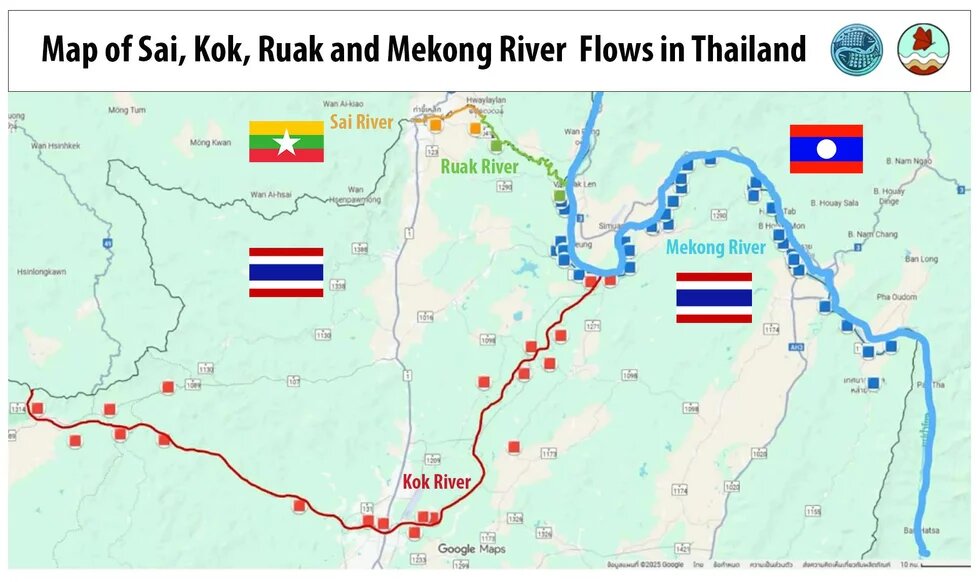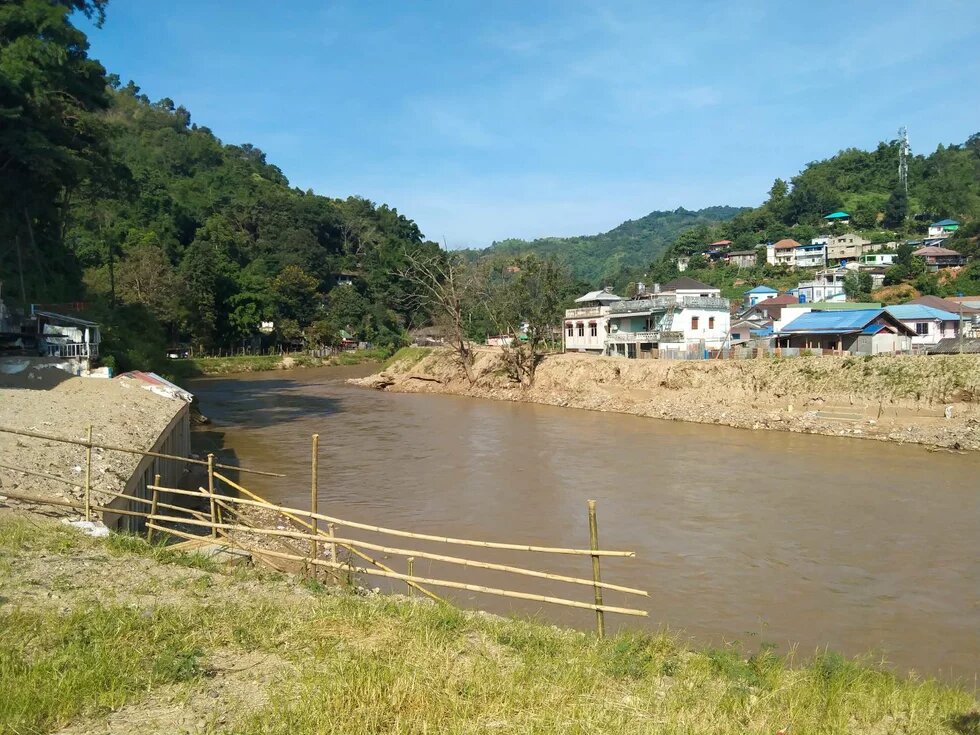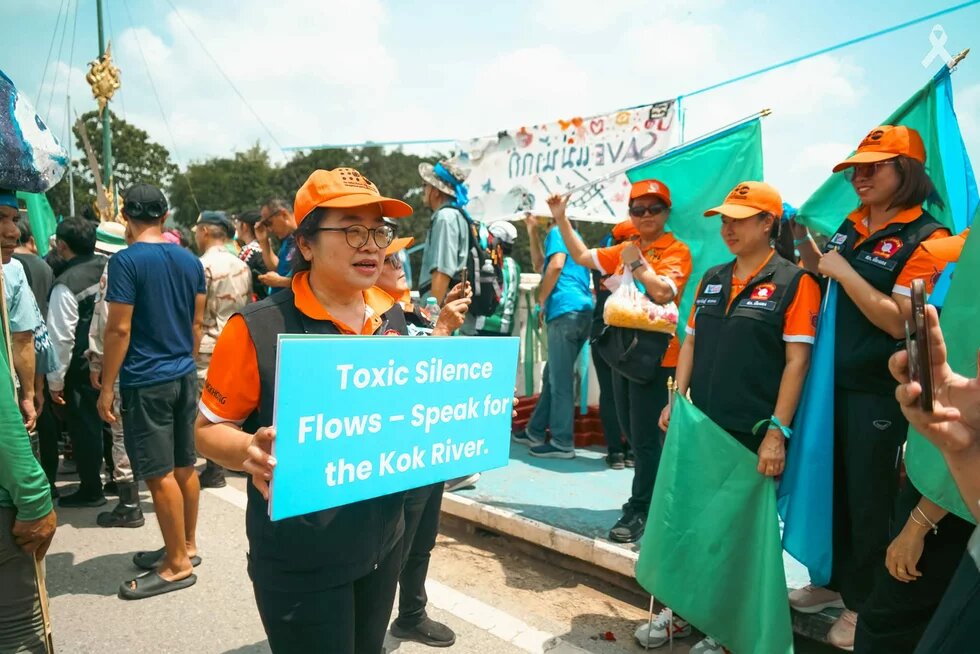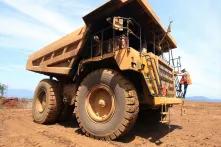
In the global bid for clean energy, Myanmar, which is embroiled in one of the world’s longest political crises is caught in the middle as the world’s most powerful nations – the United States, India and China race to access its rare earth elements (REE) and critical mineral (CTM) deposits. Despite Myanmar’s rich natural resources, its people remain impoverished and vulnerable to the actions of competing armed factions. Beyond these power struggles, neighboring countries including Thailand and Laos also suffer the consequences of large-scale mining operations, which ultimately contaminate the Mekong River and its tributaries. This article explored these power dynamics and examines how they shape social conditions and inflict ecological harm.

Introduction
The Kok, Sai, and Ruak rivers are tributaries of the Mekong River, with their headwaters located in Shan State, Myanmar. The Kok River flows into Thailand through Chiang Mai Province, continues through Chiang Rai Province, and eventually joins the Mekong River. The Sai and Ruak rivers form part of the border between Thailand and Myanmar before flowing into the Mekong River at the Golden Triangle or the countries of Laos, Thailand, and Myanmar.
The peoples of Myanmar, Laos, Thailand, Cambodia, and Vietnam, depend on the Mekong River for their livelihood – fishing, farm irrigation, and domestic water consumption as well as for transportation and commerce. In early April of 2025, Thai authorities announced that heavy-metal contamination exceeding safety standards had been detected in all three rivers, as well as in the Mekong River. The presence of heavy metal in the Kok, Sai, Ruak rivers and eventually in the Mekong River originating from mining operations in Myanmar, remains a serious problem for the communities in Chiang Mai and Chiang Rai, one that shows little possibility of resolution.
The transboundary toxic pollution exposes the scale of the issue: from a problem at the Thai-Myanmar border, to a national challenge, and quietly into a regional concern for countries in the lower Mekong basin. The impacts of mining also reflect global geopolitical tensions among powerful nations competing for dominance over rare earth elements. This article highlights the importance of understanding this issue through two interwoven dimensions. The first issue shows how rare earth elements (REEs) and critical minerals (CTMs) mining in Myanmar exemplifies the contradictions of the global energy transition. The second points to the situated complexities of border relations among Thailand, Myanmar, China, and India, which further complicate any attempt at resolution.
Mining in Myanmar and the contradictions of the global energy transition
Mining plays a crucial role in the global energy transition, yet it simultaneously contributes to environmental problems. While the energy transition is promoted as a part of global agenda for sustainable development, it often contradicts itself. On one hand, energy transition-driven policies emphasize environmental protection; on the other, mining as the starting point of the mineral supply chain continues to produce adverse social and environmental impacts. A clear example is the transboundary impact of mining activities in Myanmar on rivers and communities in Thailand.
The United Nations Conference on Trade and Development (UNCTAD) lists 60 critical minerals (CMs) and 17 rare earth elements (REE) as of extreme importance to clean energy production and technology. UNCTAD recommends developing countries to take advantage of the energy transition as an opportunity for trade and economic growth.[1] Myanmar has become one of the world's top five largest suppliers for at least two minerals – Heavy Rare Earth Elements (HREE) and tin. Myanmar is the world's third largest HREE supplier, accounting for 10.6% of the global supply, after China and the US and whose shares accounted for 66.3% and 13.3% respectively. It also ranks as the world's fourth largest tin supplier, accounting for 13.9% of the global supply, after China and Indonesia which ranked first (26%) and second (16.8%) respectively.[2]
Rare earth elements (REEs) and critical minerals (CTMs) mining in Myanmar contradicts the energy transition because this policy is posing adverse social and environmental impacts on Myanmar, Thailand, and other countries in the Mekong region.[3] Rare earth mining in Myanmar began in the areas of Kachin State bordering China before expanding[4] rapidly into the neighboring Shan State, without accountability for human rights or environmental protection.[5] As eastern Shan State borders Thailand, the impacts of the mining activity began to affect Thai territories.[6]In September 2024, the unprecedented severe flooding[7] in Mae Sai and Mueang Districts of Chiang Rai province triggered the first warning signs of the transboundary impacts of further mining activities in Myanmar – now occurring in the areas of Shan/Wa state. Large volumes of mud, brought by the flood were deposited across residential properties. It was only in April 2025[8] when the Pollution Control Department of the Ministry of Natural Resources and Environment began to test the water quality in the Kok, Sai, Ruak and Mekong rivers. High levels of heavy metal exceeding the safety standards were detected.[9] Contamination was not only found in Thailand, but also in the Mekong River, a large transboundary river of the lower Mekong basin nations where its tributaries Kok, Sai and Ruak Rivers converge. Many REE mines in Myanmar are located along the tributaries of the Mekong.[10] In July 2025, the Mekong River Commission (MRC) officially expressed concerns over arsenic contamination identified through recent water quality assessments.[11]
The adverse social and environmental impacts of unregulated mining in Myanmar is not a new issue. Impacts of REE and CTM mining are a global issue. Many international development institutions have been seeking solutions and promoting best practices for mining to resolve its contradictory extractivism. For example, the United Nations' Guidance for Action on Critical Energy Transition Minerals, United Nations Conference on Trade and Development (UNCTAD) presents a report on the OECD Due Diligence Guidance for Responsible Supply Chains of Minerals from Conflict-Affected and High-Risk Areas;[12] the Association of Southeast Asian Nations (ASEAN) releases a report titled "Strengthening ASEAN Cooperation in Minerals";[13] and the Asian Development Bank (ADB) puts forward a report named "Advancing Resilient and Sustainable Development of Critical Minerals in Asia and the Pacific.[14]
However, these recommendations for structural transformation and energy transition have their own contradicting complexities. If we consider further spatial complexities in the context of mining where Myanmar borders China, Thailand, and India, the challenges only expose the dynamic power relations embedded deep in extractivism at the borderland.
Mining and situated complexities at the borders
Being situated, unregulated mining in Myanmar, as the source of transboundary toxic pollutions, further complicates the issues. Historian Oscar J. Martínez (1994), [15] who specializes in border studies, suggests that there are many types of borderland interactions, ranging from alienating, co-existing, interdependence, and integration. What's important is the recognition of the borderland as having its own social lives or the "Border Milieu." Cross-border communications between neighboring countries and domestic ethnic conflicts and mediations are key components of the dynamic power relations among different actors that make borderland mining possible. Such deep multi-scalar power dynamics further complicate the complexities and the process to seek resolutions.
Rare earth elements (REEs) and critical minerals (CTM) mining in Myanmar is scattered haphazardly in Kachin and Shan States. Due to prolonged ethnic conflicts and mediations in Myanmar, Kachin State which borders China, was the first target for REE mining for export to China. The Kachin Independence Army (KIA) uses its control of the territory, where these critical resources are located, to negotiate with China for political and economic gains.[16]
The National Democratic Alliance Army (NDAA) controls northeastern Shan State and also conducts large-scale REEs mining for export to China. Most of these mining operations sit at the headwaters of the Mekong’s tributaries.[17] The United Wa State Army (UWSA), operating from its headquarters in northern Shan State, maintains close military and economic ties with China. UWSA's mining activities have expanded from northern to the eastern Shan State along the tributaries that eventually converge with the Mekong River and, the Myanmar-Thai border, where gold and HREE mining has taken place at the headwaters of the Sai and Kok Rivers.[18]
In addition to the domestic ethnic conflicts and ongoing mediations, Myanmar's interactions with China, India and other powerful neighboring powerful nations, as well as distant Western countries such the United States of America that seek access to valuable critical minerals further complicate its mining operations and add new layers of complexity to their impacts. China was the first nation to monopolize access to territories in Kachin and Shan States by supporting and exerting influence over ethnic armed organizations, thereby benefiting from their mining operations.[19] The International Energy Agency (IEA) estimates that China accounts for about 61% of global rare earth production and 92% of rare earth processing.[20]
With the increasing demands and competitions for HREEs, India, as Myanmar's neighboring country bordering Kachin State, has repeatedly sought to gain control of HREE in the region.[21] Similarly, the US, albeit its distant location and sanction on Myanmar, prioritizes its global trade competition with China and is exploring the possibility of exploring ways to access the resources in Kachin State as well.[22]
The complexities at the borders of Myanmar, China, India, and Thailand are key factors that make mining operations possible. Each government's decision and actions on this issue reveal the multiplying complexities in resolving this transboundary issue.
On World Environmental Day, 5 June 2025, the Kok-Sai-Ruak-Mekong Protection Network rallied in Chiang Rai and submitted a letter demanding that the governments of Thailand, Myanmar, and China, along with the UWSA, address the toxic contamination in the rivers caused by unregulated mining in Myanmar.[23] The Chinese government responded evasively to the demand. On one hand, it appeared as though China implicitly acknowledged the de facto involvement of Chinese investors in mining operations in Myanmar and expressed its willingness to cooperate in resolving the issues. On the official Facebook page of the Embassy of the People’s Republic of China in Thailand, the spokesperson released a public statement that read:
"Question: Recently, a few media outlets reported that the levels of heavy metals in Thailand's Kok, Sai, and other rivers exceeded the standards, allegedly due to mining operations in Myanmar by Chinese companies. What is the Embassy of the PRC in Thailand's response to this issue?
The Chinese government instructs Chinese companies operating in foreign countries to always abide by local laws and regulations. China is willing to cooperate closely with other nations in the Mekong region to jointly protect the ecological environment and water quality of the Mekong basin."[24]
However, after the statement, China has not taken any evident action to demonstrate its sincerity as the leader in the Mekong region. This appears that China is seeking to maintain its control and benefit from mining activities fueled by its neighbor's internal conflicts, while preserving its position as a global leader in REE and CTMs market by doing business without adequate regard for human rights or the environment.
The Myanmar junta, United Wa State Army (UWSA), Kachin Independence Army (KIA), and National Democratic Alliance Army (NDAA) have so far not issued any official response to the concerns raised by affected communities across the border regarding the water contamination caused by mining operations within their territories. However, it is not surprising at all. Neither the Myanmar junta nor the ethnic armed organizations have responded to the demands of the affected populations in neighboring country concerning mining activities under their control.
The Myanmar junta formally informed the Thai government that it had never granted approval for mining in Shan State, publicly denying the fact. It further reported that the concentration of heavy metals detected in water quality tests conducted in Myanmar remained within the national safety standard.
When the Thai government requested the formation of a joint committee to assess water quality in August 2025, the Myanmar junta accepted the invitation but explicitly stated that the central government might not be able to access territories under the control of the ethnic armed organizations. This claim contradicted the junta’s recent actions, as it had recently met with the UWSA leaders in Panghsang, the UWSA's capital, in July 2025 in preparation for the upcoming election scheduled for December 2025.
Conclusion
This article reveals the contradictions and complexities of transboundary pollution and heavy-metal contaminations resulting from mining in Myanmar and their impacts on the Kok, Sai, Ruak, and Mekong Rivers. Rare earth elements (REE) and critical minerals (CTM) mining, on one hand, responds to the growing global demands for energy transition. Yet, on the other hand, these mining operations cause significant social and environmental harms.
The resulting transboundary impacts are even more complex due to the intricate power dynamics among various actors in the borderlands of Myanmar, its neighboring countries, and distant great power nations. Recognizing these tortuous and contradictory complexities explain why resolving this issue remains such a formidable challenge. Perhaps Thailand’s next election anticipated in March 2026 may offer a clearer indication of the way forward.
Click this link for this article in Thai language
___
Suebsakun Kidnukorn (PhD.) is a lecturer at the School of Social Innovation at Mae Fah Luang University in Thailand. In the transboundary environmental issues, he has voiced deep concern over the severe water pollution in rivers such as the Kok, Sai, Ruak and the Mekong, primarily linked to upstream unregulated rare earth mining operations in Myanmar.
Disclaimer: This published work was prepared with the support of the Heinrich Böll Stiftung. The views and analysis contained in the work are those of the author and do not necessarily represent the views of the foundation. The author is responsible for any liability claims against copyright breaches of graphics, photograph, images, audio, and text used.
References
[1] Trade in critical minerals shapes energy transition, digital transformation and industrial development worldwide, https://sdgpulse.unctad.org/critical-minerals/#
[2] Trade in critical minerals shapes energy transition, digital transformation and industrial development worldwide (Ibid.)
[3] Rare Earth Mining in Mainland Southeast Asia — River Basins Dashboard, https://www.stimson.org/2025/rare-earth-mining-in-mainland-southeast-asia-river-basins-dashboard/
[4] 700 local Thais gather to protect Kok River as 24-hour gold mining continues 30 kilometers upstream in southern Mong Hsat, https://shanhumanrights.org/700-local-thais-gather-to-protect-kok-river-as-24-hour-gold-mining-continues-30-kilometers-upstream-in-southern-mong-hsat/
[5] Satellite images and videos reveal 19 rare earth mines in NDAA-controlled area of eastern Shan State near Mekong River, https://shanhumanrights.org/satellite-images-and-videos-reveal-19-rare-earth-mines-in-ndaa-controlled-area-of-eastern-shan-state-near-mekong-river/ and
Mud-laden floods destroy farmlands in Mong Khark downstream of northern UWSA rare earth mines, https://shanhumanrights.org/mud-laden-floods-destroy-farmlands-in-mong-khark-downstream-of-northern-uwsa-rare-earth-mines/
[6] The Wartime Mining Boom Exporting Rare Earths, and Toxins, https://www.nytimes.com/2025/07/11/world/asia/myanmar-mining-thailand-china.html
[7] Thai government study identifies eastern Shan State mining as cause of unprecedented mud damage in Mae Sai during recent flooding, https://shanhumanrights.org/thai-government-study-identifies-eastern-shan-state-mining-as-cause-of-unprecedented-mud-damage-in-mae-sai-during-recent-flooding/
[8] Arsenic Alert in Kok River Prompts Cross-Border Pollution Probe, https://www.nationthailand.com/news/general/40049935
[9] MNRE has taken a collaborative approach to address the contamination in the Kok River and mitigate its impact on local communities, https://www.pcd.go.th/pcd_news/35662/
[10] Satellite images and videos reveal 19 rare earth mines in NDAA-controlled area of eastern Shan State near Mekong River (Ibid.)
[11] MRC Addresses Kok River Water Quality Concerns, Regional Meeting Set for Next Steps, https://www.mrcmekong.org/media-releases/pr_07042025
[12] OECD Due Diligence Guidance for Responsible Supply Chains of Minerals from Conflict-Affected and High-Risk Areas, https://www.oecd.org/en/publications/oecd-due-diligence-guidance-for-responsible-supply-chains-of-minerals-from-conflict-affected-and-high-risk-areas_9789264252479-en.html
[13] OECD Due Diligence Guidance for Responsible Supply Chains of Minerals from Conflict-Affected and High-Risk Areas, https://asean.org/wp-content/uploads/2022/04/Development-Prospects-of-ASEAN-Minerals-Cooperation-DPAMC.pdf
[14] Advancing Resilient and Sustainable Development of Critical Minerals in Asia and the Pacific, https://www.adb.org/publications/development-critical-minerals-asia-pacific
[15] Oscar J. Martínez (1994), Border People: Life and Society in the U.S.-Mexico Borderlands, University of Arizona Press.
[16] Rare Earths and Realpolitik Kachin Control, Chinese Calculus, and the Future of Mediation in Myanmar, https://www.stimson.org/2025/rare-earths-and-realpolitik-future-of-mediation-myanmar/
[17] Satellite images and videos reveal 19 rare earth mines in NDAA-controlled area of eastern Shan State near Mekong River (Ibid.)
[18] Toxic Rare Earth Mining is Ruining Mekong Tributaries in the Golden Triangle, https://www.stimson.org/2025/toxic-rare-earth-mining-is-ruining-mekong-tributaries-in-the-golden-triangle/
[19] China risks global heavy rare-earth supply to stop Myanmar rebel victory, https://www.asahi.com/ajw/articles/15891929
[20]Why the US needs China's rare earths, https://www.bbc.com/news/articles/c1drqeev36qo
[21] Exclusive: India explores rare-earth deal with Myanmar rebels after Chinese curbs, https://www.reuters.com/world/china/india-explores-rare-earth-deal-with-myanmar-rebels-after-chinese-curbs-2025-09-10/
[22] Exclusive: Trump team hears pitches on access to Myanmar's rare earths, https://www.reuters.com/world/china/trump-team-hears-pitches-access-myanmars-rare-earths-2025-07-28/
[23] Northern rally demands end to river-polluting Myanmar mining, https://www.bangkokpost.com/thailand/general/3042617/northern-rally-demands-end-to-river-polluting-myanmar-mining
[24] Chinese Embassy Bangkok, https://www.facebook.com/ChineseEmbassyinBangkok




